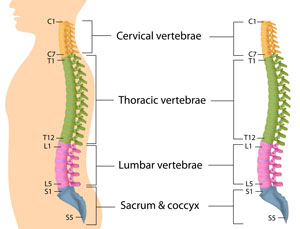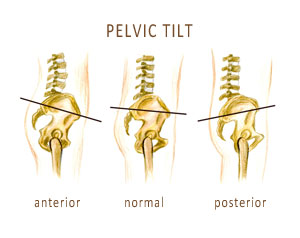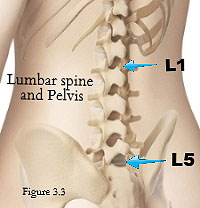
Your Lumbar Spine
By Sherwin Nicholson | May 4, 2020
Your spine (A.K.A. The vertebral column) is a dynamic structure that is able to perform an amazing range of movements while under stress. It is constantly and actively supporting you. Unless you are lying down using a strict neutral position, your back is always undergoing some amount of pressure and stress.
A healthy back MUST provide the following functions to remain pain free:
- providing continuous support for the body and head
- maintaining correct and upright posture
- allowing the body a wide dynamic range of movements and positions
- withstanding pressure and shock to the body
- supporting the rib cage and vertebral muscle groups
- providing protection for the spinal column.
If you’ve ever hurt a disc or suffered a severe spasm, you’ve found almost all of the above functions very hard to do.
Your Spinal Column
Protecting your spinal column is essential as it contains all of the major nervous supply that runs from the brain to the body and in return.
The protection begins with 34 specialized and highly versatile bones known as your vertebrae. These vertebrae each must intricately stack on top of each other in order to ‘articulate’ well. It’s this bending, twisting and weight bearing that must be perfectly done to prevent injury.
The vertebrae connect using very strong ligaments and joints (known as facet joints) which are a part of every vertebra.
In between each vertebra is a highly specialized and crucial cushion known as your vertebral disc. These discs are what provide the protection for your spinal column from daily shock and stress.
The most actively used (and worn) part of your back is the lowest disc of your lumbar: the L5-S1. Because it suffers the most wear, you’re very likely to feel the most discomfort in this area first.
The 4 Sections of the Spine
There are 4 sections to your spine (diagram 3.1). Each section contains a specific number of vertebrae and adjoining discs. Of the Cervical, Thoracic, Lumbar and Sacrum & Coccyx, it’s the lumbar vertebrae that must endure the most demanding strains and forces.
T he 5 vertebrae and discs of the Lumbar region must accommodate and support the entire upper body continuously without rest during active times of the day.
he 5 vertebrae and discs of the Lumbar region must accommodate and support the entire upper body continuously without rest during active times of the day.
Even while at rest, such as sitting or lying down, the lumbar area must always continue to provide support.
The different sections or regions each have a specific curvature. The lumbar and cervical vertebrae curve forward while the thoracic and sacral curve backwards.
Together, these curves (along with your muscles) provide the proper shape and posture required for your back. This posture is what is important for you. Correct alignment is necessary to help protect the vertebral discs and the spinal column.
The Normal Curve and Pelvic Tilt
The normal curve and pelvic tilt you need can be seen in this pelvic tilt image (neutral tilt). This is when the spine is properly aligned with the pelvis, and the supporting muscles are  balanced.
balanced.
The spine can then provide adequate resilience during movement. The exertion from walking, running, jumping, etc., can be absorbed with minimal impact to the brain and the vertebral discs.
Lifting, holding or moving objects require a normal curve and neutral pelvic tilt to protect the region.
However, when there are muscle imbalances of the vertebrae and pelvis, the curve can become either too excessive or too relaxed. This creates either an anterior pelvic tilt or a posterior one. Here, the exaggeration to the curve causes stress to your discs and muscles.
If neglected, your supporting muscles will begin to fatigue and lose adequate conditioning. The neutral curve and tilt that you lose pose a risk to your vertebral discs and facet joints.
To reverse this, strengthening and stretching some of the muscle groups will help to support your spine. This way, you can maintain a normal, neutral posture, curve and tilt.
The Lumbar Region (L1-L5)
Whenever your pain is associated with your lower back, it is generally related to this region. It is the L1-L5 vertebrae  and adjoining discs (Figure 3.3) that make up this region.
and adjoining discs (Figure 3.3) that make up this region.
These 5 very complex and strong vertebrae consists of multiple bony structures that join very strong yet flexible ligaments, tendons and muscles.
Facet joint capsules are what link your vertebrae together to provide protection to the spinal column and allow the spine to move and flex in a controlled fashion. The lumbar spine also has a complex nerve and blood supply for itself to function.
Within the vertebral space exists a complex network of nerves and nerve roots to transmit signals between the brain and the rest of the body. Any disc bulges or shrinkage can interfere with this space. Compromising this space will lead to pain that can travel down your leg.
Your spine is an incredibly strong and resilient structure and yet can be highly flexible and mobile. It is able to be rigid and immobile to maintain strength and posture while also able to move along different planes by flexing, extending, twisting and bending sideways.
The vertebral disc that sits in between your L5-S1 vertebrae absorbs and endures the most stress and pressure. There is an extremely high degree of pressure that it must withstand when you move. The L5-S1 disc is know to subject to the greatest pressures from the body.
80% of forward flexion occurs in the lumbar vertebrae. 20% occurs between the L4-L5 disc while 60% occurs between the L5-S1.
Unfortunately, it suffers the most wear and injury. For us, this translates to pain. A loss of disc height also results in a very significant loss of flexibility. As we age (30 years and older), disc height decreases.
The Low Back Pain Program provides specific exercises to help maintain the proper pelvic tilt and to reduce imbalances of pressure on the lumbar region. It will help you to follow practical and useful exercises for the back, hips and leg muscles to reduce stress on the spine and pelvis.
The benefit of the program is that it progresses you through specific levels of exercise with both the assumption that your mobility is already compromised and limited and also that you are also hurting.
As you focus on this area of difficulty, you can safely treat yourself at your own pace. As your pain decreases, you will move to a level of strength building and reconditioning.
The third level is designed to protect you from injury and pain recurrence. The final level helps to keep your muscles and body adequately conditioned and prepared to everyday activities that previously would have hurt you. You use the exercises from this final level when and as needed to stay ‘back healthy’.
To learn more about the program go to the Check out the Table of Contents to see the exercises that will help you.
If you are ready to begin the program to relieve your pain, Order/Download the book to begin right away.
References:
- Back Pain – The Facts – John Lee, Clare Daniel, Suzanne Brook. NY. Oxford University Press – 2009. 617.564Lee
- The Wharton’s Back Book – x2003. 617.564Wha. Emmaus, Pa. Rodale Inc. Wharton, Jim.
- Slipped disc- Overview-http://www.ncbi.nlm.nih.gov/pubmedhealth/PMH0048469/
